
A rapidly-intensifying storm is expected to bring heavy snow, blizzard conditions, and icing from the Upper Midwest through the Great Lakes and Northeast. Scattered severe thunderstorms may produce severe/damaging wind gusts and a couple of tornadoes across parts of the Midwest and lower Ohio Valley through the evening. Arctic air will expand across the central and southern U.S.. Read More >
There are several different types of instrumentation used by Cooperative Weather Observers to keep track of the weather. The instruments are identical at all stations across the country. Cooperative Observers typically measure two things, precipitation and temperature.
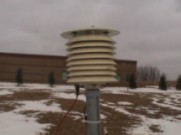
Figure 1
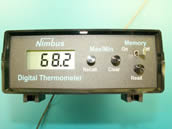
Figure 2
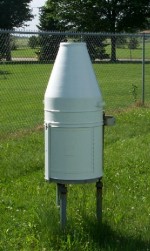
Figure 3
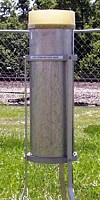
Figure 4
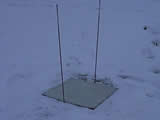
Figure 5
National Weather Service Co-Op sites use a Maximum/Minimum Temperature Sensor (MMTS). The MMTS is a RTD type thermometer, meaning it uses electrical resistance to record the temperature. The RTD sensor is housed in a "beehive" (figure 1). The "beehive" also rests at the standard 5 ft level. A cable carrying the signal from the temperature sensor extends into a nearby building, where it is output on a display box (figure 2). Resetting is done with a few simple button pushes.
The accuracy of the MMTS is typically within 0.5 degree F.
The maximum and minimum temperatures are then recorded online, to be transmitted to the National Weather Service and the National Climatic Data Center.
Co-Op observers measure 24-hour precipitation totals. The precipitation measured may be in the form of rain, snow, sleet or freezing rain, depending on the time of year.
The two main pieces of equipment used for precipitation measurements are the Fisher & Porter Gauge (FPG) and the Standard 8 inch diameter Rain Gauge (SRG).
The FPG is essentially a scale that weighs how much water has fallen. Rainwater enters the gauge through an opening at the top (figure 3). It then collects in a container inside the closed cylinder. The container rests on a scale, which records the weight of the water. This measurement is then recorded by a computer at 15 minute increments. The data are downloaded with a flash drive and e-mailed to the local WFO at the end of each month, and is then sent to the National Climatic Data Center (NCDC) in Asheville, NC.
The Standard Rain Gauge (SRG) is the primary precipitation instrument used at co-op sites. The precipitation collects into a plastic cylinder which is housed inside the larger 8 inch diameter metal cylinder (figure 4). The observer then removes the cylinder and measures the depth of the liquid precipitation with a supplied ruler. If frozen precipitation such as sleet or snow is found in the gage, the observer takes the sample inside and melts it down before measuring it. The measurements are then recorded online. From there, they are sent to NCDC in Asheville, NC.
The amount of snow that has fallen in the past 24 hours and the total depth of snow on the ground at the observation time are also recorded during the snow season. Observers use a snow board (figure 5) to measure the snowfall, and a yard stick to measure the average snow depth.